- Back to Home »
- Tons of poisoned fish clog river
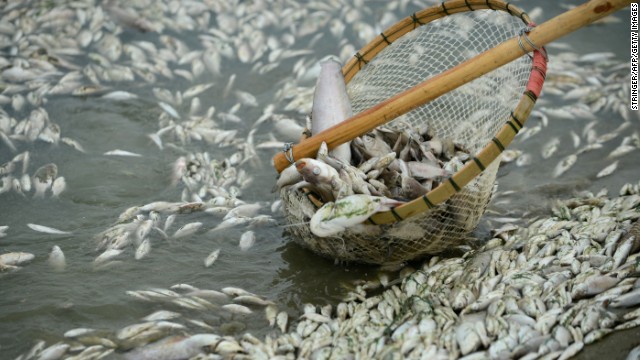 Dead fish are cleared from the Fuhe River in central China's Hubei province on Tuesday, September 3. Officials believe that the fish were poisoned by high levels of ammonia discharged into the water from a chemical plant. The company has been ordered to suspend operations by provincial environmental authorities.
Dead fish are cleared from the Fuhe River in central China's Hubei province on Tuesday, September 3. Officials believe that the fish were poisoned by high levels of ammonia discharged into the water from a chemical plant. The company has been ordered to suspend operations by provincial environmental authorities. 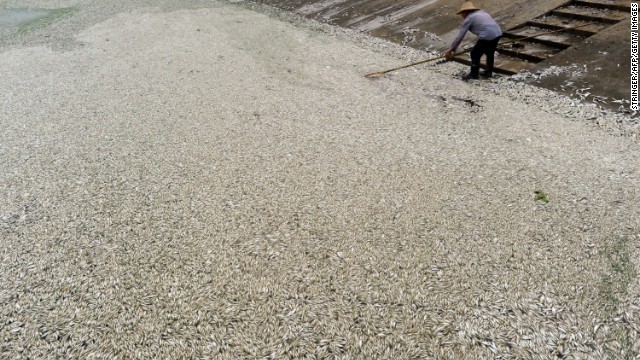 A resident clears dead fish from the river on September 3, the day after large numbers began to surface.
A resident clears dead fish from the river on September 3, the day after large numbers began to surface. 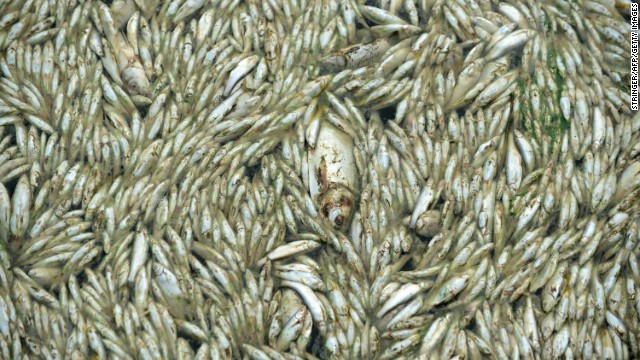 Authorities have cleared about 110 tons of dead fish from the river.
Authorities have cleared about 110 tons of dead fish from the river. 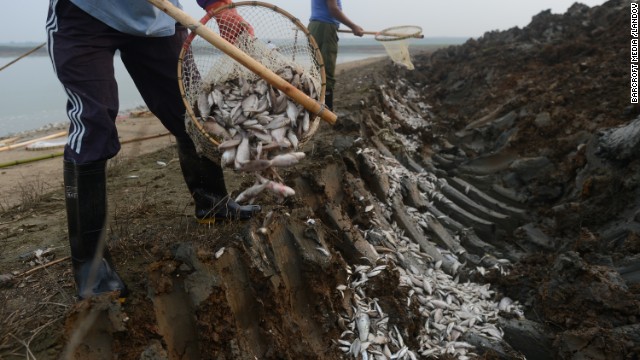 Two men bury dead fish September 3 to prevent them being sold at market.
Two men bury dead fish September 3 to prevent them being sold at market. 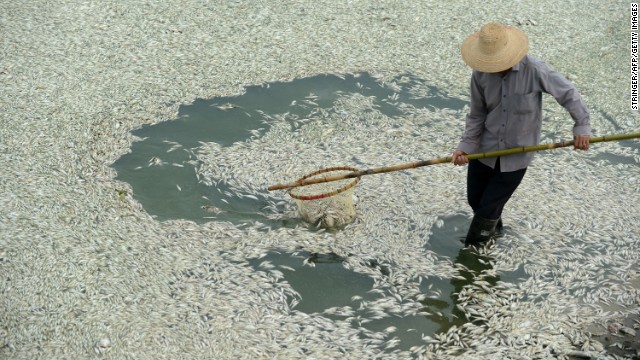 The dead fish were found over a 40-kilometer stretch of the river.
The dead fish were found over a 40-kilometer stretch of the river.  A man surveys the scene on the river.
A man surveys the scene on the river. 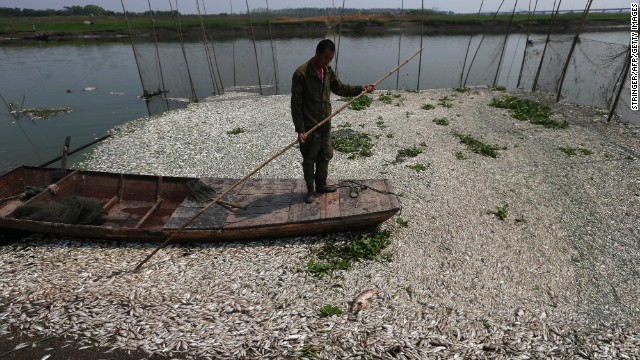 A fisherman makes his way through the fish-clogged river.
A fisherman makes his way through the fish-clogged river. - Authorities have cleared about 110 tons of dead fish from the Fuhe River
- Officials believe they were poisoned by ammonia from a chemical plant
- The company has been ordered to suspend operations
- The dead fish were found over a 40-kilometer stretch of the river in Hubei province
Hong Kong (CNN) -- After the thousands of dead pigs, come the tons of poisoned fish.
The Fuhe River is the scene of the latest disturbing example of river pollution in China.
Authorities cleared about 110 tons of dead fish from a 40-kilometer section of the river in the central province of Hubei, the state-run news agency Xinhua reported Wednesday.
Images taken at the scene this week showed thousands of silvery fish carcasses blanketing large expanses of the river and its shore.
 China's 'cancer villages'
China's 'cancer villages'  Pollution causing cancer in this village?
Pollution causing cancer in this village? 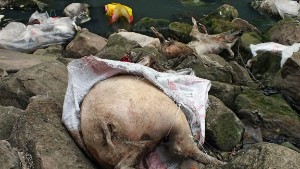 Pollution an economic concern in China
Pollution an economic concern in China The cause of the deaths, provincial environmental officials said, was the discharge of high levels of ammonia into the water by a local chemical plant in Yingcheng, outside the city of Wuhan.
Kite detects pollution, shines light on Beijing smog
Samples taken at a water outlet from the plant on Tuesday indicated that ammonia density reached 196 milligrams per liter, a level "far in excess of the national standard," Xinhua reported, citing the provincial environmental protection department.
The World Health Organization says that natural levels of ammonia in groundwater are normally below 0.2 milligrams per liter and that surface waters can contain as much as 12 milligrams per liter.
The Hubei environmental authorities ordered the company that runs the plant, Hubei Shuanghuan Science and Technology Stock Co., to suspend operations at the plant and sort out its pollution controls, Xinhua said.
CNN made repeated calls for comment Thursday, but the company's office line was busy. Its stock was suspended from trading on the Shenzhen stock exchange Wednesday.
In an update Thursday, the environmental protection department said that a recent drought in the area had "caused (a) significant drop in water level, which decreased the river's capacity to hold pollutants."
Domestic sewage mixed with untreated waste from the chemical plant and a paper mill "have caused the biological crisis" in the river, the department said in a statement.
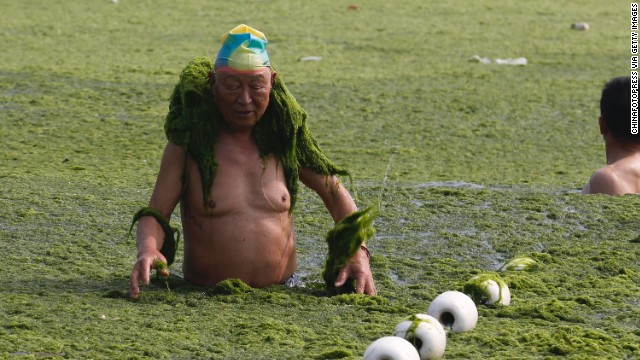 Tourists swim in seawater covered by a thick layer of green algae on July 3, 2013 in Qingdao, China. A large quantity of non-poisonous green seaweed, enteromorpha prolifera, hit the Qingdao coast in recent days.
Tourists swim in seawater covered by a thick layer of green algae on July 3, 2013 in Qingdao, China. A large quantity of non-poisonous green seaweed, enteromorpha prolifera, hit the Qingdao coast in recent days. 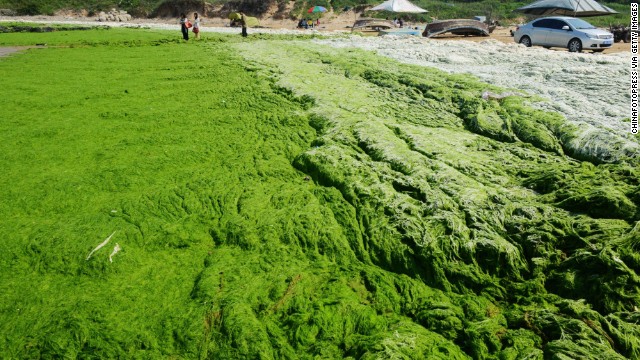 For the seventh year in a row, monstrous quantities of green algae have sprouted in the coastal waters near Qingdao.
For the seventh year in a row, monstrous quantities of green algae have sprouted in the coastal waters near Qingdao.  This year's growth, covering 28,900 square kilometers (11,158 square miles), is the biggest outbreak ever recorded, state-run news agency Xinhua reported.
This year's growth, covering 28,900 square kilometers (11,158 square miles), is the biggest outbreak ever recorded, state-run news agency Xinhua reported. 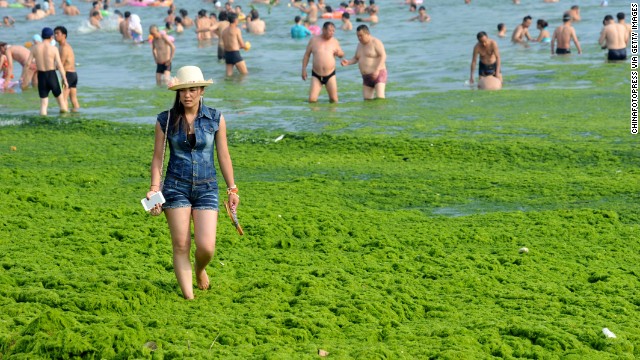 Tourists play at a beach covered by a thick layer of green algae on July 3 in Qingdao.
Tourists play at a beach covered by a thick layer of green algae on July 3 in Qingdao. 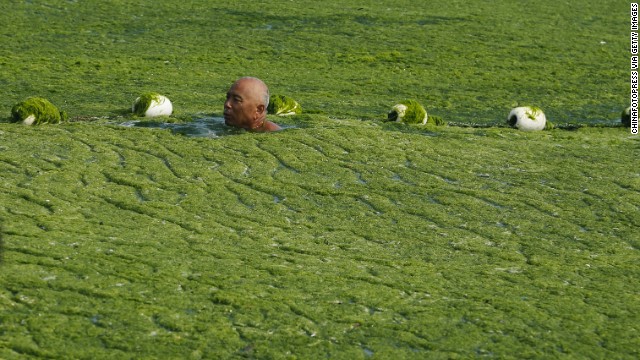 Chinese officials have blamed past algae outbreaks on unusually warm seas. But scientists say that agricultural waste, industrial pollution, and human sewage are often to blame.
Chinese officials have blamed past algae outbreaks on unusually warm seas. But scientists say that agricultural waste, industrial pollution, and human sewage are often to blame. 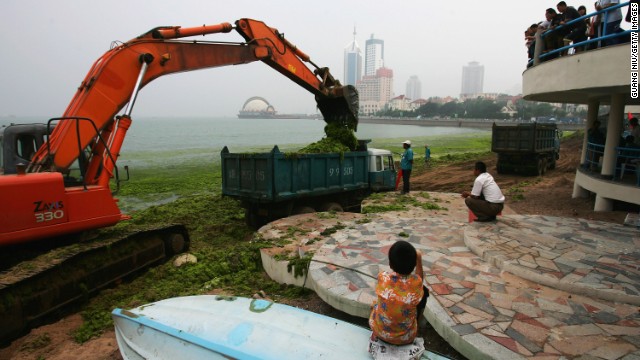 A file photo from the 2008 cleanup. A researcher says that algae does not typically cause health problems, but skin inflammation may be a risk. "If you were stupid enough to go in, I wouldn't go in naked," said Dr. Christopher Bolch, of the University of Tasmania.
A file photo from the 2008 cleanup. A researcher says that algae does not typically cause health problems, but skin inflammation may be a risk. "If you were stupid enough to go in, I wouldn't go in naked," said Dr. Christopher Bolch, of the University of Tasmania.  Swimming in slime
Swimming in slime Great green blob covers Chinese waters
'Serious' pollution problems
A villager who lives near the river, Li Songqing, told the local newspaper Chutian Metropolitan that the dead fish had been piling up since early Monday.
"Nearly all fish died out in this section, no matter if they were big or small," he said.
Environmentalists said this added to other problems in the area.
"The environment of this region is already under extreme stress," said Ma Tianjie, who manages Greenpeace's campaign against toxic chemicals in East Asia. "The addition of these incidents will definitely worsen the situation."
People on China's Twitter-like microblog service, Weibo, reacted to the news with a mixture of anger and sarcasm.
"Why can't we solve these problems and stop them from happening beforehand?" asked the user @Kanfangzu.
"The water quality must be fine, and this is just a mass suicide of the fish," quipped another user, @Niyaobuyaolianguidouhaipa.
The poisoning of the fish is the most recent pollution scandal in China, which has many rivers and lakes with water quality problems.
In a 2009 report, the Ministry of Environmental Protection said pollution of surface water "remained serious."
In the ministry's most recent report, it said that about 30% of the rivers that it monitors are considered to be polluted.
Earlier this year, the discovery of thousands of bloated pig carcasses in a river near Shanghai caused widespread alarm.
At the time, officials blamed local pig farmers for dumping the dead animals in the river.
CNN's Dayu Zhang in Beijing contributed to this report.







